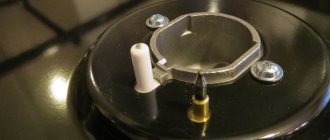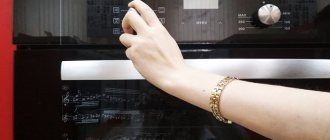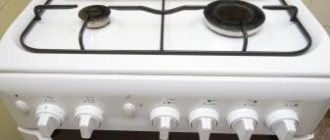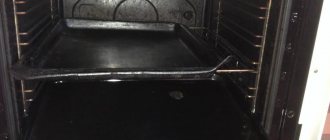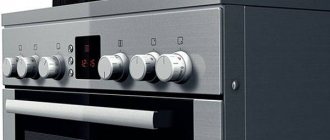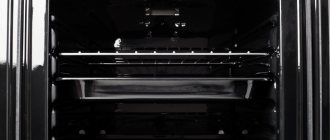One of the main reasons holding back consumer demand for gas stoves is the possibility of a fire hazard. When faced with the problem of choosing a stove, people often wonder: what is the gas control function in gas stoves? It turns out that it is a special mechanism for stopping the supply of gas fuel in the event of a fire extinguishing.
Gas control device for a gas stove - how to turn it off and how dangerous it is
The combination of traditions and modern developments makes it possible to simplify household chores and ensure human safety.
This applies to popular, economical and convenient gas stoves. In addition to standard programs (timer, electric ignition), many devices are equipped with a special gas control option, which is extremely important due to the explosiveness of gas. We will find out what gas control is in a gas stove, what the purpose and operating principle of this function are, and we will also find out how to turn it off if necessary.
The main causes of gas oven malfunctions
Here are the main reasons why the oven in a gas stove does not work well or does not work:
The thermocouple tip may have moved from the place where it should be located, and for this reason the oven does not warm up enough. To correct this failure, you need to place the tip exactly in the flame
You can do this yourself, acting carefully and accurately.
The thermocouple tip became very dirty during oven operation. In this situation, the oven may not work well or stop functioning altogether.
You can clean it yourself by watching a video or reading tips on the Internet. Other failures in the gas control system that require specialist intervention. There is no point in looking for causes and eliminating them on your own. It's best to call a professional. Who exactly to call can be found in the newspaper or on the Internet.
It is not always possible to determine the cause on your own, so it is better not to try. Even masters can make mistakes.
Gas stove with gas control function: purpose of the system
What is it - gas control of the oven and burners in a gas stove? This is a function that prevents gas leakage and allows you to protect a person from a fire or explosion.
Function Purpose:
- automatic shutdown of gas supply in case of flame extinguishment;
- there is no need to closely monitor the cooking process;
- prevention of explosions, fires, poisonings;
- providing the user with peace of mind even in emergency situations.
These are the main advantages of the system. But it is not without its drawbacks :
- unstable operation of the stove in case of system failure;
- complex repairs;
- long ignition of the burner.
In early models, the function was installed on the entire stove . In modern devices, each burner and oven are equipped with their own sensors, due to which the supply of flammable substances is stopped selectively, and not immediately to the entire stove.
Reference. Popular models with built-in gas control include De Luxe 506040.03g, Gorenje GI 5321 XF, Gefest PG 5100-04 002.
Operating principle
The design of the control system for the burners and oven of the stove consists of several elements:
- thermoelectric converter (thermocouple) - two connected wires, which are made of different materials and connected to the valve;
- solenoid valve - a device that shuts off the supply of a flammable substance in the event of a sudden extinguishment of the flame;
- flame sensor - a thermoelement placed at the fire level.
The principle of operation is based on the joint and sequential functioning of all elements of the system and looks like this:
- Pressing, turning and holding the knob on the panel with built-in electric ignition opens the gas supply and lights a fire on the stove burner or in the oven.
- The flame heats the thermocouple.
- The thermocouple transmits the signal from the sensor to the solenoid valve.
- During normal operation the valve is open.
- If the flame goes out, the valve stops receiving the signal and goes into the closed position.
After the system is triggered, it takes some time for the stove to turn on , since the thermocouple does not heat up immediately. In different models this happens after 1-5 or 15-20 seconds, sometimes more.
Nuances
The mode and operating principle of gas control has some nuances:
- For each ignition, you need to wait 15–20 seconds until the required temperature is reached.
- If the ignition time increases, it means that the electric couple is clogged or dirty.
- It is unacceptable to independently change the operation of the system in an attempt to reduce the ignition time.
- The reason for lack of ignition is not always the gas control sensor. Sometimes fuel may not flow into the burner due to clogged holes.
To avoid problems and fines, be sure to call a professional if there is any problem with your gas equipment.
How to disable the system
The system ensures safety, but brings some inconveniences , the main of which is an increase in the time it takes to turn on the stove and unstable operation of the burners if the mechanism breaks down.
In this regard, many users refuse the gas control function in a gas stove.
To disable the feature, you must do the following :
- Close the valve supplying gas to the device.
- Determine the location of the system (it is different for all models).
- Disconnect the thermocouples from the solenoid valve.
- Remove the valve.
- Unscrew the spring that provides the gas supply/shutoff mechanism.
- Reinstall the valve and reassemble the entire mechanism.
It is when the spring is removed that the solenoid valve loses its ability to control the gas supply.
Important! The given algorithm should not be considered as a guide to action, as it is unsafe. You should invite a gas service technician who will turn off the system and, after carrying out the work, make appropriate notes in the equipment operation log.
Why does the flame go out in the oven?
In a gas oven, the flame goes out immediately after ignition or during short operation for the following reasons:
- The gas regulator is not working. The oven cannot be lit.
- Strong seal on the oven door. This leads to a lack of air during combustion. And as a result, the gas fades out during operation.
- The thermocouple has failed or is burnt. If after cleaning it does not return to working condition, then the part must be replaced.
- The temperature sensor has left the flame zone. Restoring its position will return the oven to operation.
- The solenoid valve is faulty. Parts need to be replaced.
- The thermostat stopped working. The technician will be able to adjust its operation or replace it.
- The contacts in the gas control system have oxidized. It is necessary to clean the contacts and restore the circuit connection.
- The thermostat is faulty. It needs to be replaced.
- Smokes the flame when burning.
It should be recalled that gas is a potentially hazardous substance. And repairs of gas equipment should only be carried out by a specialist who has a special permit for this type of work. For repairs, in addition to knowledge and experience, special equipment is also required. You should not try to repair a gas stove yourself. This can lead to even greater damage and irreparable consequences.
Is the gas going out on the stove? Contact service. The specialist will be able to come to your home on the same day of your request. Leave a request on the website or call 8(495)707-05-05.
Gas control of gas stove burners and ovens: what is it and why is it needed?
Many apartments and houses still have gas stoves. Most often, owners have no choice, because if there is a gas pipe, then an electric stove may simply not be suitable due to high electricity consumption.
However, gas is a dangerous substance, and its leakage can lead to catastrophic consequences. But manufacturers think about safety, so almost every modern stove has a gas control system. Let's look at what it is - gas control of burners and ovens, how it works and whether it is worth buying a stove with this option at all.
Popular models
The gas control mode in kitchen stoves is now as popular as, for example, a timer or auto-ignition. Almost every manufacturer produces models that support this mode.
- The domestic brand De Luxe offers an inexpensive but worthy model – 506040.03g. The hob has 4 gas burners with electric ignition using a button. Low flame mode supported. The oven has bottom gas heating and internal lighting, is equipped with a thermostat and a mechanical timer. Gas control is maintained only in the oven.
- Slovenian company Gorenje, model GI 5321 XF. It has classic dimensions, which allows it to fit perfectly into your kitchen set. The hob has 4 burners, the grates are made of cast iron. The oven is made like a wood stove with optimal distribution of hot air.
Other advantages include heat-resistant enamel coating, grill and thermostatic heating. The door is made of double-layer thermal glass. The model has automatic ignition of the burners and oven, as well as an electric timer. Gas control is maintained on the hob.
- Gorenje GI 62 CLI. A very beautiful model in a classic style in ivory color. The model has 4 burners of different sizes, including WOK. The oven is made in the Home Made style with thermostatic heating. The burners and oven have automatic ignition. The model is equipped with an alarm clock, timer, jets for bottled gas, Aqua Clean cleaning, and is distinguished by the presence of full gas control.
- The Belarusian brand Gefest is another well-known manufacturer of gas stoves with gas control support (model PG 5100-04 002). This device has an affordable price, but includes all the necessary equipment for convenient and safe use. Has a white color.
The hob has four burners, one with fast heating. The coating is enamel, the grates are made of cast iron. The model is distinguished by the presence of a grill, thermostat, lighting, and electric ignition for both parts. Gas control is maintained in all burners.
Other well-known brands - Bosch, Darina, Mora, Kaiser - also actively support the function of partial or complete control of blue fuel leakage. When considering a particular model, you need to ask the seller how long the protection will be activated.
When choosing a kitchen stove, you must take into account the gas control mode, which you can adjust yourself. It undoubtedly increases the cost of the product. But guessing about the price is inappropriate when it comes to family safety.
You can find out how to turn off the gas control in the oven below.
Design and principle of operation
The essence of the gas control is extremely simple - if the fire is extinguished by something, accidentally or not, then the gas stops flowing to the burner, thereby preventing its leakage and accumulation in the apartment. The most popular reasons for the unintentional extinguishing of a fire are considered to be a draft or boiled-over liquid.
But how does the system figure out that the fire has gone out? In fact, the gas control device is extremely simple. The main part can be called a thermocouple - these are two fused metal wires from different materials, the end of which is led to the burner, namely to the fire.
When you turn the stove handle, the fire turns on, the wire heats up and creates an electromagnetic field - this is the basis for the operation of the gas stove thermocouple.
This field affects the magnet to which the handle of the plate is connected. The magnet acts on the spring, opening the gas supply valve. If the fire suddenly stops, the wire will no longer heat up and, therefore, create an electromagnetic field. The gas control valve will simply close without the action of the magnet and the gas supply will stop.
If this happens, then simply repeat the ignition. It will take 5 to 20 seconds for the thermocouple to heat up again. All this time you will have to hold the burner knob in the desired position, otherwise the cold thermocouple will extinguish the flame again.
How to change a thermocouple?
Only a specialist should replace the device, as this is very dangerous. If the fastening is not airtight, then any breakdown of the device will give a spark, which will cause the gas stove to explode. To avoid a fire in your home, do not replace the thermocouple yourself, but ask a specialist to do it.
To replace the device, you will need to buy a new thermocouple from a specialized store. When choosing this device, choose only a high-quality device that will serve you for many years. Before buying a new device, consult with a specialist who will recommend exactly the sensor that is suitable for your gas stove or water heater.
Replacing a thermocouple sensor on a gas boiler is a little more complicated. In a gas boiler, a thermocouple made of chromium and aluminum or chromel and copel is most often used; an iron constant is less often used. All of these metals are designed to withstand high temperatures, and such sensors are often used in the foundry industry.
The gas boiler control system consists of an electromagnetic valve and a thermocouple.
To replace a device, you need to follow a series of sequential steps.
- Using a wrench, unscrew the nuts that secure the thermocouple to the solenoid valve, then you need to remove one of the ends of the thermocouple.
- Inspect the connectors. If they contain various contaminants or oxidation, they must be cleaned. For this you will need fine-grained sandpaper.
- Check the thermocouple sensor using a multimeter. To do this, attach one of the metal ends of the device to the multimeter, and heat the other with a lighter or torch. The multimeter reading should be within 50 mV.
- After that, if the indicator matches the data, you need to collect it in the same sequence. If not, then most likely it will have to be replaced.
Replacing the thermocouple in the oven of a kitchen gas stove is carried out differently. First you need to remove the lid of the gas stove; it is located on the opposite side from where the oven tap handle is located.
Remove the cap, but first clean it with sandpaper. If the terminal is removed, the cap rotates freely. When you see the center valve, check it. If it is faulty, it needs to be replaced. Remove the terminal by pulling it downwards with your fingers. Remove the cap and turn off the valve on the gas riser; now you can connect the burner and check the operation of the device.
After this, use a wrench to unscrew the nut and carry out diagnostics. Check the valve and thermocouple separately.
Advantages and disadvantages
The main advantage of gas control is safety. News reports often contain reports of gas explosions in residential buildings. All of them could have been prevented if the stove had a working gas control system.
This option is especially useful for families with small, inquisitive children or elderly and slightly absent-minded parents.
The gas control system allows:
p, blockquote 17,0,0,0,0 —>
- relax a little and don’t sit in the kitchen all the time cooking to watch the fire;
- prevent accidental gas leaks, and therefore explosions, fires and poisonings;
- provide protection from children who like to twist the handles. When you press it briefly and release it again, the gas stops flowing. Usually the child is not able to hold the handle in one position long enough to allow the gas to turn on.
But such a system also has negative sides:
p, blockquote 19,0,1,0,0 —>
- The first thing people complain about is how long it takes to turn on the burner. The fact is that the thermocouple sensor does not heat up instantly, so the knobs must be held for about 5 seconds before the gas control starts working. If the stove is old or not properly maintained, this time can be increased to 20 seconds.
- The second negative point is related to the fact that the gas control is a device made up of several parts. This means that it may break, malfunction, or simply not work. This is quite rare, but still occurs. Replacing or repairing this system yourself is not so difficult, but it is dangerous and prohibited by law.
- The third common complaint from people is that the gas control is activated even on a small fire and turns it off. That is, it will not be possible to simmer the porridge over low heat, since it will constantly simmer. This is not a completely correct situation - ideally this should not happen. Most likely, we are talking about loose thermocouple contacts, so it is better to call a technician.
A separate category of people is based on the fact that previously there was no gas control in the stoves, and everyone lived somehow. In their opinion, this option only increases the cost of the gas stove. In fact, the prices for equipment without and with gas control are approximately equal. The difference of a couple of thousand rubles is completely incommensurate with the security that this system provides.
Advantages of installing HBO
Saving on fuel. Yes, gas consumption is 10-15% higher compared to gasoline, but due to the twofold difference in cost, you will be able to save significantly with large annual mileages.
The economic benefit of converting a car to gas per 1 km can be calculated using the formula (X * ( Y₁ - 1.2 * Y₂)) / 100, where
- X - fuel consumption of the car, liters of gasoline per 100 km
- Y₁ — price of a liter of gasoline
- У₂ — price of a liter of liquefied gas
- 1.1 is an increasing factor, because gas consumption will be on average 10-20% higher than gasoline
By dividing the cost of installing LPG by the resulting savings per kilometer, we obtain the payback period for the equipment based on the vehicle mileage.
Example. Andrey's car consumes 14 liters of AI-95 per 100 km. A liter of gasoline costs $0.77, a liter of propane costs $0.42. With the installation of HBO, Andrey will save (14 * (0.77 - 1.2 * 0.42)) / 100 = $0.037 per 1 kilometer. If Andrey supplies a 4th generation gas equipment manufactured in Europe at an estimated cost of $750, the payback for the gas equipment will occur in ($750 / $0.037) 20.27 thousand km . This is the approximate mileage of the car per year.
At the same time, when calculating the payback of gas equipment, it is important to take into account the cost of gasoline , which the engine will consume for starting and warming up, as well as in maximum load mode. Plus the cost of servicing gas equipment: replacing filters every 20 thousand km (liquid phase filter) and 10 thousand km (vapor phase filter). Plus a one-time payment for making changes to the registration certificate when registering gas equipment.
In turn, installing gas equipment will allow you to save on replacing engine oil, oil and fuel filters due to an increase in the service interval by one and a half to two times. The service life of spark plugs also increases with the installation of gas equipment.
Power reserve on one fill. Due to the parallel use of gas and gasoline, the total mileage at one gas station doubles. A solid power reserve will be useful on a long journey and will allow you to avoid refueling in the provinces or neighboring countries.
Reliable engine starting . Even if the fuel pump has died, the car with LPG will start. The fuel pump often fails suddenly - and the owner is left without wheels. But if the car is switched to gas, you can warm up the gearbox with hot water and start the engine on gas - this is enough to get to the service station under your own power.
Environmental friendliness. Using gas as fuel reduces the level of harmful emissions into the atmosphere. Gas is three times more environmentally friendly than gasoline, does not contain sulfur and additives, like diesel fuel. In terms of toxicity, only electric motors and hydrogen engines are lower than gas. Environmental friendliness of cars is valued in Europe. Restrictions on entry into certain areas of vehicles using “heavy” fuel are not dangerous for cars with LPG.
Increased engine life. The octane number of gas is higher—about 110—and it burns longer and more evenly than gasoline. This means that the shock loads on the CPG are lower, and detonation in the combustion chamber is eliminated. The wear and tear on engine parts with LPG is 30-45% less compared to a gasoline engine. Owners of gas-powered cars note softer, smoother engine operation, reduced noise and vibration. Propane-butane is supplied to the combustion chamber in an optimal gaseous state and mixes more evenly with air. Due to this, the CPG parts experience less load, and no deposits or soot remain on the cylinder walls. Engine oil in gas cars is cleaner and lasts longer. The protective lubricating film is not washed off from the cylinder walls, as happens with gasoline.
What about the disadvantages?
The Internet is full of legends about the terrible consequences of switching a car to gas. The discussions are mostly between armchair experts. Typical opinions are that LPG “kills” the engine, it burns out the pistons and valves in the cylinders; the gas will definitely explode; To convert a car to gas, you need to go through half the car, and so on.
In fact, there were problems with the relationship between gas equipment and CPG engines during the times of first-generation carburetors and gas equipment. Modern engines with HBO generation 4, 4+ have nothing to fear if they are installed and configured correctly. A gasoline controller and a set of sensors are responsible for the correct preparation of the mixture.
We discussed in detail the explosiveness of gas, the complexity of its maintenance, damage to the engine and other folk mythology in the article “Five myths about the dangers of gas equipment that prevent you from saving.” Recommended reading.
Among LPG installers and those interested, there is an expression “addicted to gas . The vast majority of car owners, after a successful gas installation experience, repeat the same thing with all their next cars - and this is perhaps the best recommendation.
To ensure that your car's conversion to gas fully meets your expectations, carefully select the LPG manufacturer, trust the installation of equipment only to specialized accredited services, and do not forget to have the cylinders serviced every 10-15 thousand km.
Causes
It is important to understand why the gas control system may fail.
If we are talking about a long time to ignite the fire when turning on the stove, then most likely the problem is a dirty thermocouple. Someone solves this problem by simply fixing the handle in the required position so as not to hold it manually.
It is better to eliminate the problem itself and call a specialist for this. If you have the skills to repair electrical equipment, then you can do it yourself - simply by removing the hob and cleaning the heating element.
If after this the problem does not disappear, then we can talk about a malfunction of the gas control system. It could be:
p, blockquote 27,0,0,0,0 —>
- solenoid valve wear;
- displacement of the thermoelement relative to the flame;
- stupor of the burner tap;
- bad contact.
There are also possible more distant reasons for the unsatisfactory operation of the stove - for example, insufficient gas pressure. It can be caused either by problems at the gas distribution substation or by a gas tap in the apartment that is not fully open.
If the problem is in the tap, then you just need to open it all the way. If the reason is in the substation, then you will have to submit an application to the local gas department.
There are few options for what to do if the gas control breaks down. It is best to immediately contact a specialist, since independent repairs are prohibited.
Diagnosis of failure
Like all technical solutions consisting of several components, gas control can fail. This is easy to diagnose. For example:
- gas is supplied even without the process of ignition and combustion;
- the burner switches off automatically;
- the flame start time (from pressing and turning the knob to the start of combustion) increases.
It is worth noting: some gas control elements require strict adjustment. That is, clear placement and configuration. Therefore, it is recommended to hire specialists to repair a gas stove. Especially if the manufacturer's warranty has not yet expired.
To prevent the gas control from failing, you must follow the rules for operating the stove: you need to keep its surface clean, regularly disassemble and wash the burners . At home, with minimal skill in using hand tools, you can clean the thermocouple.
To do this, remove the hob. In some models of stoves, the burner can be disassembled to access the thermocouples. After this, the element is cleared. This must be done carefully so as not to deform or displace the thermocouple.
If the user does not have experience in disassembling hobs, it is recommended to seek help from specialists. An additional motivation for this decision will be the listing of simple facts: gas control may not work due to incorrect installation of the thermocouple, loose connections, jamming of moving parts, wear of electromagnetic coils.
You may be interested in: how to fix electric ignition.
How should gas burn properly?
A necessary condition for the combustion of gas in household appliances is its combustion when oxygen is supplied. The main component of natural gas is methane. The combustion process consists of the oxidation of methane with oxygen contained in the air mixture. For complete combustion of 1 liter of gas, 2 liters of pure oxygen or approximately 10 liters of air mixture are required. When natural gas burns completely, it releases heat, light, carbon dioxide and water vapor. In this case, the flame has a blue color. The supply of the required amount of air mixture for combustion is ensured by the injection function. With the help of an injector built into the hob, atmospheric air is sucked in and mixed with gas. The burners light correctly if:
- The gas burns silently blue.
- The flame is even and strong.
- Lights up without popping.
- Combustion proceeds silently.
- The flame does not go out when the regulator is set to the minimum value.
